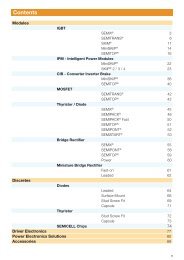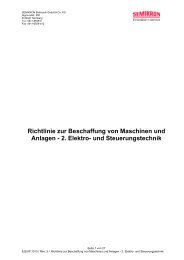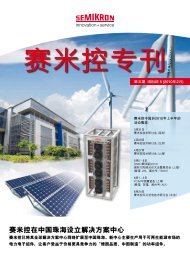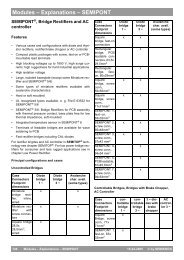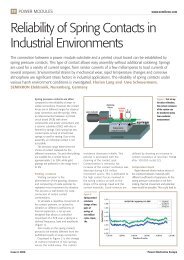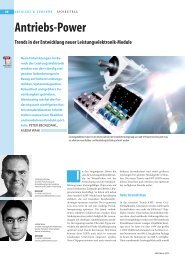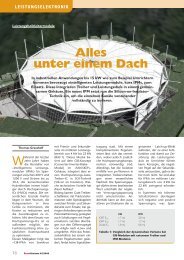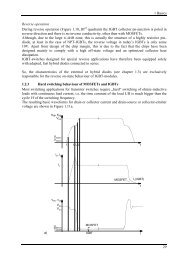Application Note - Semikron
Application Note - Semikron
Application Note - Semikron
Create successful ePaper yourself
Turn your PDF publications into a flip-book with our unique Google optimized e-Paper software.
<strong>Application</strong> <strong>Note</strong> AN-11001<br />
When an inner IGBT (T2 or T3) is switched off before the<br />
corresponding outer IGBT (T1 or T4) the inner switch<br />
would be exposed to the full DC-link voltage. In case this<br />
voltage was higher than the blocking voltage of that<br />
semiconductor it would be destroyed.<br />
As shown in Fig. 4 there are switching patterns that are<br />
not allowed because they are destructive. Those states<br />
must be avoided if the device shall not be destroyed.<br />
TNPC:<br />
There is no mandatory switching sequence for the TNPC<br />
converter: any IGBT may be switched on and off at any<br />
time because there is no danger that one semiconductor<br />
is exposed to a voltage higher than its blocking voltage.<br />
NPC & TNPC:<br />
The gate signals of T1 and T3 (T2 and T4 respectively)<br />
are invers. It has to be made sure that one IGBT is<br />
securely switched off before the other one is switched on.<br />
Emergency shut-down<br />
There are several events that may occur which in 2L<br />
application lead to immediate switch-off by the driver to<br />
protect the semiconductors. Imaginable events are:<br />
- thermal overload<br />
- current overload or<br />
- desaturation.<br />
Any of these scenarios must lead to a quick shut-down in<br />
3L application as well.<br />
NPC:<br />
But it must be made sure that the correct switch-off<br />
sequence is maintained: outer IGBT first (T1 or T4), inner<br />
IGBT afterwards (T2 or T3) to avoid destruction due to<br />
voltage breakdown.<br />
Where thermal overload or a slowly rising current can be<br />
monitored with NTC/PTC and current sensors and leave<br />
some time for the supervising controller to react in an<br />
appropriate time, a desaturation event leaves a<br />
maximum of 10µs time for switch-off.<br />
When an outer switch (T1 or T4) desaturates it may be<br />
switched off immediately by the driver. After 1..3µs the<br />
according inner IGBT is to be switched off as well.<br />
It gets more complicated, when the desaturation happens<br />
at an inner switch (T2 or T3): when the event is<br />
monitored the driver must have the information if an<br />
according outer switch is switched on as well or not. If it<br />
is switched on the gate driver must switch off the outer<br />
IGBT immediately, wait 1..3µs and then switch off the<br />
inner IGBT as well. If no outer IGBT is switched on the<br />
driver must switch off the inner IGBT immediately.<br />
In any case the driver generates an error message so<br />
that the controller can shut down the other devices of the<br />
converter as well and so establish a secure state.<br />
TNPC:<br />
Again it is much easier in TNPC topology because no<br />
switch-off sequence must be maintained.<br />
No matter if thermal or current overload or a desaturation<br />
event happens, the converter may be switched off<br />
immediately.<br />
Protection of 3L devices against voltage<br />
overshoots<br />
As soon as a current path is interrupted (by switching off<br />
an IGBT or a diode) the voltage across the switched off<br />
device begins to rise. This voltage overshoot is caused<br />
by the energy stored as magnetic field of the current<br />
path. The energy increases linearly with rising stray<br />
inductance L S (E = 0.5*L S*i²); e.g. doubled parasitic<br />
inductance L S causes doubled energy E. The voltage<br />
overshoot (V = L S*di/dt) is added to the DC-link voltage;<br />
the sum must not exceed the blocking voltage of the<br />
semiconductor as it would be destroyed.<br />
Due to the fact that a 3L module is larger than a 2L<br />
device and a conduction path inherits two switches the<br />
current paths are longer and hence the stray inductances<br />
higher. Especially the long commutation paths (NPC<br />
topology; T2/D5 D3/D4 or T3/D6 D1/D2) must be<br />
payed attention to when the module is designed.<br />
While with a good design low values of the stray<br />
inductances can be realised (e.g. SKiM4 MLI: 28nH per<br />
switch, approx. 60nH for the long commutation path) it is<br />
not possible to construct a low inductive 3L setup with<br />
standard 2L modules. The long commutation path<br />
passes at least three modules in NPC topology (see Fig.<br />
20) or two ot three modules in TNPC topology (Fig. 21)<br />
what leads to a stray inductance of about 200nH. That is<br />
more than three times as much as in the dedicated 3L<br />
module. Assuming the di/dt is the same this setup<br />
produces more than three times as much voltage<br />
overshoot.<br />
For that reason SEMIKRON recommends the use of<br />
dedicated 3L modules.<br />
If there are no further possibilities to reduce the voltage<br />
overshoot at its root cause (i.e. even shorter connections<br />
between the semiconductors which at a certain point is<br />
not possible any more) the overshoot needs to be<br />
handled in a way protecting the semiconductors.<br />
Snubber<br />
Snubber capacitors can be connected to DC+ and N<br />
respectively N and DC-. They must be positioned as<br />
close to the module as possible and can be chosen<br />
according to the hints given in SEMIKRON <strong>Application</strong><br />
<strong>Note</strong> AN-7006.<br />
Active Clamping<br />
Another way to handle harmful voltages is to use an<br />
active clamping network at the IGBTs (Fig. 23).<br />
8 / 12 2012-09-03 – Rev04 © by SEMIKRON



